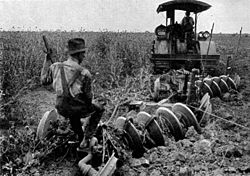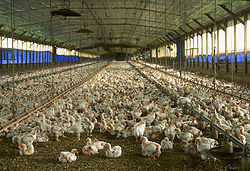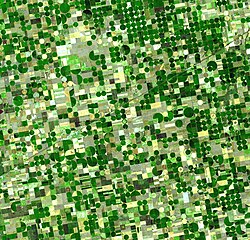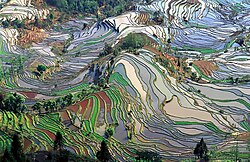Intensive farming
Intensive farming or intensive agriculture is a kind of farming where a lot of money and labour are used to increase the yield that can be obtained per area of land. The use of large amounts of pesticides for crops, and of medication for animal livestocks is common. This is a contrast to traditional agriculture, which does not get as much output per area. When agriculture is intensified, this means that the amount of work needed goes up, until the worker is replaced by a machine. At that point, there will only need to be a few workers to operate the machines. Intensive farming has often been done as a response to rising population levels. It is criticised, because the standards of animal welfare are low.[1] Intensive animal farming leads to increased pollution and to health issues.[2][3]
Modern day forms of intensive crop based agriculture involve the use of mechanical ploughing, chemical fertilizers, plant growth regulators or pesticides. It is associated with the increasing use of agricultural mechanization, which have enabled a substantial increase in production, yet have also dramatically increased environmental pollution by increasing erosion and poisoning water with agricultural chemicals.
History
Agricultural development in Britain between the 16th century and the mid-19th century saw a massive increase in agricultural productivity and output. This in turn contributed to increase in population growth.[4]
Industrial agriculture arose in the Industrial Revolution. By the early 19th century, agricultural techniques, implements, seed stocks, and cultivars had improved so much.[5]
Horse-drawn machinery such as the McCormick reaper improved harvesting. Inventions such as the cotton gin reduced the cost of processing. During this same period, farmers began to use threshers and tractors that were powered with steam.[6][7][8] In 1892, the first gasoline-powered tractor was successfully made. Mechanical harvesters, planters, transplanters, and other equipment were then developed, further improved agriculture.[9] These inventions increased yields and allowed individual farmers to manage larger farms.[10]
Nitrogen, phosphorus, and potassium (NPK) were discovered to be very important in plant growth. This led to the manufacture of synthetic fertilizers, further increasing crop yields.[11]
The discovery of vitamins and their role in nutrition, in the first two decades of the 20th century, led to vitamin supplements, which in the 1920s allowed some livestock to be raised indoors, reducing their exposure to adverse natural elements.[citation needed]
Following World War II synthetic fertilizer use increased rapidly.
The discovery of antibiotics and vaccines improved the raising of livestock by reducing diseases. Developments in refrigeration as well as food processing technology made it possible to transport goods over long distances.
There are concerns over the sustainability of industrial agriculture, and the environmental effects of fertilizers and pesticides. This has led to people buying organic food. It has also led to the funding for the development of sustainable technology.[12]
Characteristics
Intensive farming has many characteristics. They include:
- Large capital/finance requirements
- Use of lots of agrochemicals (e.g. pesticides and fertilizer)
- Improved varieties of crops and animals
- Lots of surplus yield for sale
- Use of modern techniques and machinery
- It is performed on huge plots of land
- Reliance on skilled labour
- Very high yields
Intensive Farming Media
Early 20th-century image of a tractor ploughing an alfalfa field
Rotational grazing of cattle and sheep in Missouri with pasture divided into paddocks, each grazed in turn for a short period and then rested
Satellite image of circular crop fields in Haskell County, Kansas, in late June 2001. Healthy, growing crops of corn and sorghum are green (sorghum may be slightly paler). Wheat is brilliant gold. Fields of brown have been recently harvested and plowed under or have lain in fallow for the year.
Overhead irrigation, center-pivot design
Terrace rice fields in Yunnan Province, China
References
- ↑ The Welfare of Intensively Kept Pigs
- ↑ Commissioner points to factory farming as source of contamination
- ↑ "Rebuilding Agriculture - EPA of UK" (PDF). Archived from the original (PDF) on 2007-09-30. Retrieved 2012-06-21.
- ↑ "BBC - History - British History in depth: Agricultural Revolution in England 1500 - 1850". www.bbc.co.uk. Retrieved 2020-11-14.
- ↑ Kingsbury, Noël. (2009). Hybrid : the history and science of plant breeding. Chicago: University of Chicago Press. ISBN 978-0-226-43704-0. OCLC 298128770.
- ↑ Oregonian/OregonLive, Allan Brettman | The (2010-07-25). "Collectors at Great Oregon Steam-Up are always steamed about their passion". oregonlive. Retrieved 2020-11-14.
- ↑ "Ottawa Valley Land Rovers - Member's Prose & Pages - Mike Rooth - Locomotives - Steam Tractor, Part I". www.ovlr.org. Archived from the original on 2019-08-29. Retrieved 2020-11-14.
- ↑ "Steam Engine in Farming". historylink101.com. Retrieved 2020-11-14.
- ↑ Janick, Jules. Agricultural Scientific Revolution: Mechanical (PDF).
- ↑ "The Impact of Mechanization on Agriculture". NAE Website. Retrieved 2020-11-14.
- ↑ Organic farming : an international history. Lockeretz, William. Wallingford, UK: CABI. 2007. ISBN 978-1-84593-289-3. OCLC 173844268.
{{cite book}}: CS1 maint: others (link) - ↑ Philpott, Tom. "A Brief History of Our Deadly Addiction to Nitrogen Fertilizer". Mother Jones. Retrieved 2020-11-14.








